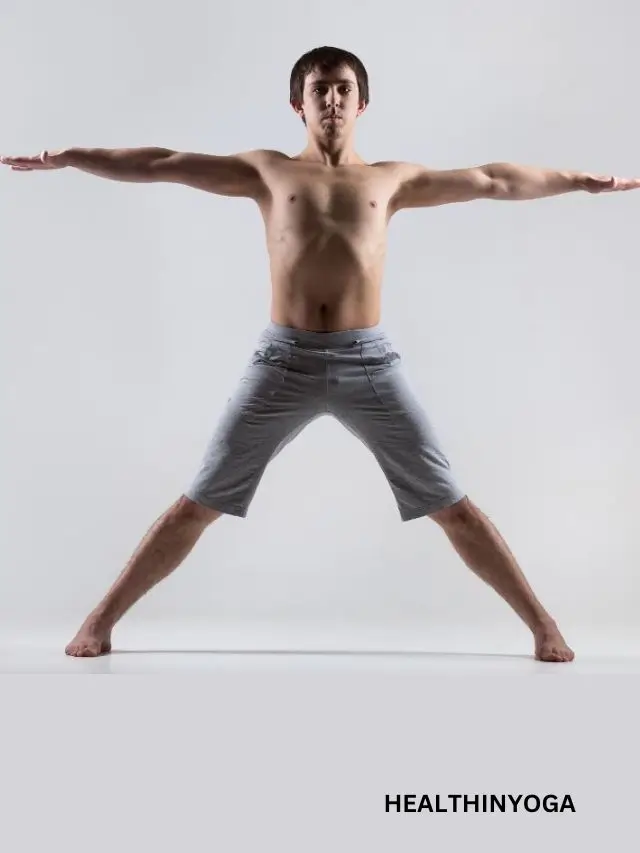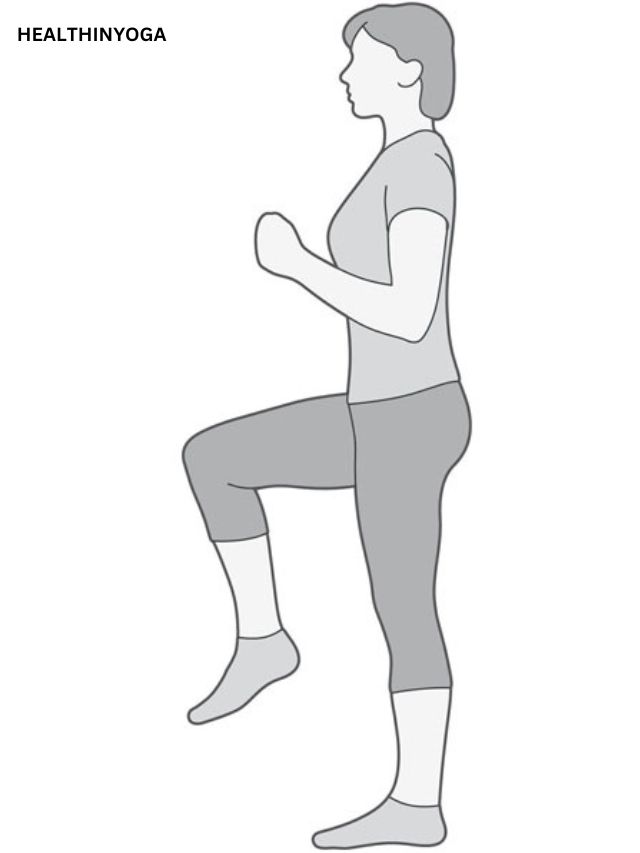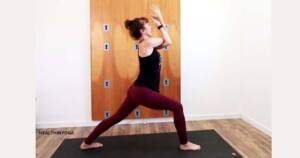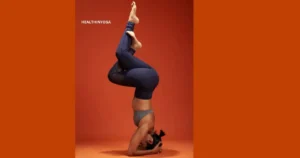Last updated on May 28th, 2024 at 11:12 am
Introduction
The mountain pose(Tadasana) is the foundation of all yoga poses. It is the start of each standing asana, the basic standing pose.
It has a lot of variations according to your body’s abilities and efficiency. These variations can improve the body’s balance, equilibrium, and coordination, and enhance awareness.
In this article, we learn about the important variations of Tadasna. The Five-Pointed Star Pose(Utthita Tadasana) and the Standing Ankle Rotating Pose. These poses encourage your self-confidence and add more challenges to your daily routine. The best part of this pose is that it can mold according to your ability, depending on the level of acceptance of challenges and difficulties.
Five Pointed Star Mountain Pose (UTTHITA TADASANA)

The name “Five Pointes Star Pose” is also known as (UTTHITA TADASANA) in the language of Sanskrit. Where
UTTHITA – STRETCHES
TADA – MOUNTAIN
ASANA – POSE
When someone performs this pose, the body alignment is like a “Star”, this pose is an ultimate representation of the energy flow through the body parts. Fingers, feet, arms, and legs are extended in all directions and denote the 5 edges of the star, that is why this pose name is a five-pointed start pose.
This pose is an excellent yoga pose for beginners an easy standing category pose, an effective way to enhance your body balance and stability. Target muscles involve the chest, spine, core, and ankles. Regular practice of this pose strengthens the body, opens the chest, promotes deep breathing, and reduces stress.
Benefits of five-pointed star pose
Regular practice has multiple benefits for physical and mental aspects. Following are the benefits of this pose are listed below
- Improve flexibility and range of motion.
- Improve the respiratory system and open the chest, rip cage, and diaphragm.
- Enhance the body balance and maintain static and dynamic balance.
- Balance all types of chakras and improve mental and physical stability.
- Help in postural correction and engaging the all-over body muscles.
- Reduces anxiety, and depression lowers stress levels, and treats mild depression symptoms.
- Stretch the spine, strengthen the core muscles, and engage the glutes, quadriceps, hamstring, and hip muscles, improving the body posture.
How To Do Five-Pointed Star Pose Step-By-Step Process
- Stand straight in a basic mountain pose, with your feet together, and maintain a space of 3-4 steps between both feet.
- Spread your arms parallel to your body, and spread the fingers of your hands evenly.
- Ensure that your feet should be under your wrist and feet should be facing forward and parallel to each other.
- Evenly dived your body weight on your feet, hold up the knee caps and nip the thigh, tuck in the tailbone.
- The feet should be firmly on the ground, and keep breathing throughout the posture.
- Inhale slowly, press your head towards and stretch the crown towards the ceiling, and chin parallel to the floor.
- Hold the posture for 30-60 seconds and breath deeply, during the practice.
- When you release the pose, lower the arms beside you and come into a mountain position. Repeat this pose 4-5 times, and relax.
Contraindications Of Five-ointed Star Pose
It is a simple extended body, standing pose, with no severe side effects on the body. Here are some precautions and contraindications, to learn before practicing this pose.
- This pose can be performed by pregnant women and senior citizens but with a wall support or under an experienced yoga instructor, it will provide more balance and stability and reduce the risk of falling.
- Severe injury in the hips, joints, shoulders, and ankles should avoid practicing this pose that will cause chronic pain, swelling, and stiffness or worsen the condition of the injury.
- Persons dealing with migraine, vertigo, and weakness should avoid practicing this pose because it demands more balance and stability.
- During pain in ankles, joints, lower back, and legs avoid performing this pose. It will cause an increase in pain and swelling in the muscles.
Standing Ankles Rotating PoseStanding Ankles Rotating PoseStanding Ankles Rotating Pose

Standing ankle rotation is also an excellent variation of the mountain pose, also known as “TADAASANA GOOLF CHAKRA”.It is a basic beginner-level, one-legged standing yoga pose, that enhances the body balance and stretches the body. This variation is usually a warm-up exercise with standing ankle rotation and prepares your body for further yoga poses.
This pose is a basic warm-up, that opens the ankle and muscles, improves ankle mobility, reduces the risk of injury, preparation for the yoga routine. This is a simple ankle-rotating standing pose, but offers multiple benefits for all well-being and health.
Benefits Of Standing Ankle Rotation Pose
This variation offers a range of benefits for ankles, feet, and legs health and well-being. It will
- Improve the body balance, and stability and improve a sense of awareness. The following benefits are listed below.
- Circulation movement of ankles improves ankle mobility, stretches and lubricates the ankle joints, increases the range of motion, and lowers the risk of injury.
- The one-legged standing pose improves balance, stability, and awareness, and reduces the risk of falling.
- Prepare Your body and reduce the stiffness of the ankles, feet, and knees, make your body ready for your future yoga routine, because it is an excellent warm-up technique.
- Improve the blood circulation of the legs, feet, ankles, and knees, and reduce the pain, swelling, and stiffness.
- This pose promotes mindfulness and relaxes the mind because it focuses on balanced breathing improving a sense of awareness, and reducing stress.
How To Do Ankle Rotation Pose Step-By-Step Process
This pose is usually a beginner, one-legged standing pose involving ankle rotation balance and stretches, a step-by-step process given below
- Stand straight and tall in a mountain pose with feet together and arms beside or resting on the hips.
- Engage your core, shift your body weight on the left leg, and keep breathing throughout the posture.
- Lift the right foot off the ground and bend the knee. Keep maintaining the balance or take wall support if facing a problem balancing.
- Start rotating your right ankle in a clockwise direction for 5-10 cycles, slowly and smoothly.
- To release the pose lower the right leg down, and relax. Repeat the same with the left leg.
Contraindication Of The Standing Ankle Rotation Pose
Here are some risks and contraindications of this pose, the following give below
- Pregnant women and senior citizens should avoid practicing this pose. Always take wall support to better balance and stability. Perform under the guidance of an experienced yoga instructor.
- If a person has an injury in the knees, joints, ankles, and feet you avoid practicing pose. Then it may cause serious strain and swelling of the injury and worsen the condition.
- If someone has issues like migraine, vertigo, or weakness avoid practicing this pose. It demands more balance and stability, or consult a doctor before practicing this yoga pose.
Other Variations Of The Mountain Pose
- Standing Cow Face Pose ( Tadasana Gomukhasana)
- Arms Strech Out 45 Degrees (Palm Tree Mountain Pose)
Conclusion
The mountain pose also named tadasana in yoga, is a basic standing posture. It has many physical and mental health benefits. Its variations are also amazing and have excellent results for your body and mind. It has many variations and modifications according to the body’s ability and stamina.
when you master the basic pose you can try more new variations of tadasana, and challenge your body and muscles. These poses improve balance, and stability and correct your body posture.
If you have any queries or suggestions, please leave a comment. We will pleased to answer all your queries. Thank you.

Honey is a certified yoga instructor with training from Patanjali Yogpeeth, Haridwar. With four years of dedicated teaching experience, she specializes in using yoga to improve spinal health, build core strength, and help people find relief from chronic pain. Her mission is to make the transformative power of yoga accessible to everyone.




